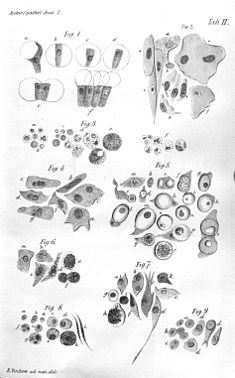Robert Hooke
 |
| plant cell |
- In 1665, he discovered a honeycomb-like structure in a cork slice by using a primitive microscope
- He saw cell walls as a dead tissue then he started introducing the word cell to world.
- He also published the first ever scientific bestseller; Micrographia
| illustration is bee's stings which have barbs at the end |
- In 1674, he discovered animalcules meaning tiny animals when he described the algae spirogyra under microscope. He also discovered other cell in his illustration:
 |
| animalcules, bacteria and spermatozoa |
 |
| a cross- sectional view of a nerve fiber |
 |
| drawings of shape and size red blood cells |
Theodore Schwann
- In 1836, he discovered the pepsin, digestive enzymes
- He also concluded that all animals are made up of cells
| animal cells |
Rudolf Virchow
- In 1855, he stated the only source for a living cell was from another living cell
3 main parts of cell theory:
- all living things are made up from cells
- the cells can perform all the function of life which is carry out life processes
- all cells are came from pre-existing cells
Exceptions to cell theory:
- viruses
- prions
- subcellular organelles which carry info and replicate independently
- multinucleated single cell;muscle cells
Modern cell theory:
- the cell contains hereditary information which is passed on from cell to cell during cell division
- all cells are basically the same in chemical composition and metabolic activities
- all basic chemical and physiological functions are carried out inside the cells
- cell activities depends on the activities of subcellular structures within the cell
PROKARYOTE VS EUKARYOTE
VIRUSES
Properties:
- no membranes, cytoplasm, ribosomes or other cellular components
- cannot move or grow but can reproduce inside a host cell-Obligate intracellular parasites
- consist of 2 major parts - a protein coat and hereditary (DNA or RNA)
- nucleic acid surrounded by a protective protein coat called a capsid
- some also surrounded by an outer membranous layer called envelope, made of lipid and protein
- come in a wide range of shapes
- can infect plants, animals, human and even bacteria and they attack only specific to their host
can be classified according to their:
- Genetic material
- Virus shape
- Symmetry of the capsid
- Presence or absence of the envelope
- Type of the host
 |
| viruses reproduce in two ways |
PRIONS
- an infectious agent that is composed primarily of protein
- propagate by transmitting a mis-folded protein state
- the process is dependent on the presence of the polypeptide in the host organism
- implicated in a number of diseases in a variety of mammals
- prion diseases - alzheimer's and parkinson's diseases, mad cow disease
VIROIDS
| viroids can cause severely misshaped potatoes |
- small circular RNA molecules without a protein coat
- can contain as few as 250 nucleotides
- infect plants
- induced diseases lead to dramatic economic losses in agriculture and horticulture worldwide








No comments:
Post a Comment